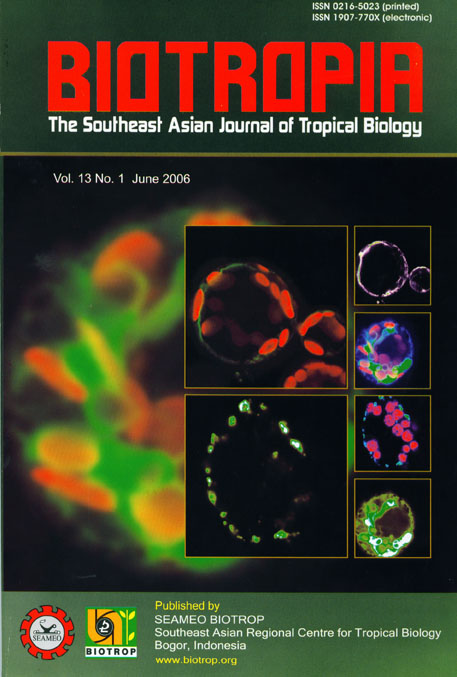
SEAMEO BIOTROP
Southeast Asian Ministers of Education Organization
857
views
Tags
SEEDBANK AND SEEDLING EMERGENCE CHARACTERISTICS OF WEEDS IN RICEFIELD SOILS OF THE MUDA GRANARY AREA IN NORTH-WEST PENINSULAR MALAYSIA
23 May 2019 - 02:00 pm (7 year ago)
Content Language : English
Content Language : English

Category :
Applied Science
Tlie experiment was conducted in the glasshouse of UPM from March 2003 to June 2004 to determine the soil
seedbank in the ricefields ot'Muda rice granary area in Peninsular Malaysia. Six soil cores of 5 cm in diameter and 10 cm
depth were sampled from each of 24 fields. All samples from each individual field were bulked and placed in plastic
trays of 38 x 25 x 10 cm. Soil was moistened as required and emergence of weed seedlings were recorded over
period of one year. After one year, remaining seeds were separated, removed and identified. The total seed bank was
estimated at 1136.48 million/ha of which 62.35% (708.60 million seedlings ha"
1
) germinated within 12 months and
37.65% (427.88 million seeds ha"
1
) remained ungerminated. Total of 20 taxa were recognized. Based on importance
value (I.V.) the five most dominant species in terms of emerged seedling were Fimbristylis miliacea, Leplochloa chinensis,
LitJwigia hyssopifolia, Cyperus difformii and C. iria. Of the remaining seeds the five dominant species with decreasing
trend in ranking were F. miliacea, Scirpus lateriflonis, Monochoria vagina/is, L. hyssopifolia and L. chinensis. Ranking
of total seed reserves (seedlings+ remaining seeds) were similar to emerged seedling indicating that emerged seedlings
reflect the actual weed flora in the Muda area. Among the dominant species F. miliacea accounted for 58.07% of emerged
seedlings, 79.31% of remaining seeds and 66.07% of total seed bank. Total seedling emergence of all species was higher
in the first observation in April 2003 and cumulative seedling emergence showed no clear peaks.
seedbank in the ricefields ot'Muda rice granary area in Peninsular Malaysia. Six soil cores of 5 cm in diameter and 10 cm
depth were sampled from each of 24 fields. All samples from each individual field were bulked and placed in plastic
trays of 38 x 25 x 10 cm. Soil was moistened as required and emergence of weed seedlings were recorded over
period of one year. After one year, remaining seeds were separated, removed and identified. The total seed bank was
estimated at 1136.48 million/ha of which 62.35% (708.60 million seedlings ha"
1
) germinated within 12 months and
37.65% (427.88 million seeds ha"
1
) remained ungerminated. Total of 20 taxa were recognized. Based on importance
value (I.V.) the five most dominant species in terms of emerged seedling were Fimbristylis miliacea, Leplochloa chinensis,
LitJwigia hyssopifolia, Cyperus difformii and C. iria. Of the remaining seeds the five dominant species with decreasing
trend in ranking were F. miliacea, Scirpus lateriflonis, Monochoria vagina/is, L. hyssopifolia and L. chinensis. Ranking
of total seed reserves (seedlings+ remaining seeds) were similar to emerged seedling indicating that emerged seedlings
reflect the actual weed flora in the Muda area. Among the dominant species F. miliacea accounted for 58.07% of emerged
seedlings, 79.31% of remaining seeds and 66.07% of total seed bank. Total seedling emergence of all species was higher
in the first observation in April 2003 and cumulative seedling emergence showed no clear peaks.
Link

This work is licensed under a Creative Commons Attribution-NonCommercial-NoDerivatives 4.0 International License.
